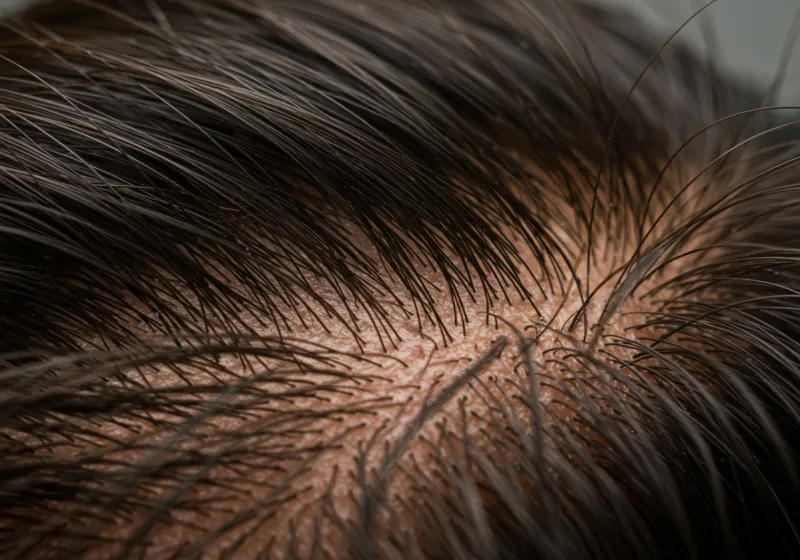Why Your Hair Gets Greasy So Fast—and How to Stop It
You know the frustrating cycle—you wash your hair in the morning, and by evening or the next day, your strands are already limp, flat, and visibly oily. This rapid return to greasiness isn’t just annoying; it can impact your confidence and have you reaching for a hat or washing your hair much more frequently than you’d like.
If you’re wondering why your hair looks greasy after just one day, you’re not alone. This common concern affects men of all hair types and ages, but the good news is that the cycle can be broken. In this guide, we’ll explore the science behind oily hair, debunk common myths, and provide actionable solutions that address the root causes rather than just masking symptoms.
1. Understanding Why Hair Gets Greasy Quickly
Before diving into solutions, it’s essential to understand what’s happening on your scalp when oil production seems out of control.
What Is Sebum—and Why Too Much Is a Problem
Sebum is the natural oil produced by sebaceous glands attached to your hair follicles. This waxy, oily substance is actually beneficial in the right amounts—it moisturizes your scalp, prevents hair from becoming brittle, and even offers some antimicrobial protection. The problem occurs when there’s an overproduction of sebum, causing it to accumulate on the scalp and travel down the hair shaft, leaving strands looking slick and weighed down.
Unlike dry hair, which is a condition of the hair shaft itself, greasy hair is primarily a scalp issue. The oil production happens at the root level, which is why even men with dry or damaged ends can experience an oily scalp.
Key Biological Triggers
Several factors can influence how much sebum your scalp produces, and many of them are outside your immediate control:
Hormones & genetics: Androgens (male hormones like testosterone) stimulate sebum production, which explains why oiliness often increases during puberty and can remain an issue for men throughout life. If your father or grandfather had oily hair, genetics might be playing a role in your situation as well.
Diet, stress, and environment: What you eat, your stress levels, and even the climate you live in can affect oil production. Diets high in refined carbohydrates, sugar, and dairy may increase sebum production in some individuals. High stress levels trigger cortisol release, which can indirectly boost oil production. And hot, humid environments can make existing oil more noticeable as it thins and spreads more easily across the scalp.

2. The Role of Washing Frequency in Oil Production
One of the most counterintuitive aspects of managing greasy hair is understanding the optimal washing frequency—it’s rarely what you might think.
Why Overwashing Backfires
If your hair gets oily quickly, your instinct might be to wash it more frequently. However, this approach often backfires. When you wash your hair too often (especially with harsh shampoos), you strip away not just excess oil but also the natural oils your scalp needs to stay healthy. Your sebaceous glands interpret this as a signal to produce even more oil to compensate for the loss, creating a frustrating cycle of increasing oiliness.
How Often Should You Really Wash?
There’s no one-size-fits-all answer to optimal washing frequency, but for most men with oily hair, gradually training your scalp to produce less oil is more effective than daily washing:
- Starting point: If you currently wash daily, try switching to every other day for 2-3 weeks.
- Transition period: Yes, your hair will feel greasier at first—this is normal as your scalp adjusts.
- Progressive training: Once your scalp adapts, you can potentially extend to washing every 2-3 days.
- Finding your balance: The goal isn’t necessarily to wash as infrequently as possible, but to find a frequency that keeps your hair looking good without triggering overproduction of oil.
Signs You’re Washing Too Much—or Too Little
Your scalp will tell you if your current routine isn’t working:
Signs of overwashing:
- Scalp feels tight or itchy shortly after washing
- Hair becomes oily again very quickly (within hours)
- Flaking that appears more like dry skin than traditional dandruff
- Hair feels stripped or straw-like immediately after washing
Signs of underwashing:
- Scalp feels constantly itchy or irritated
- Noticeable buildup or residue at the roots
- Unpleasant odor even after basic hygiene
- Visible flaking combined with oiliness

3. Choosing the Right Products for Oily Hair
The products you use can either exacerbate oiliness or help manage it effectively. Here’s how to build a routine specifically for oily-prone hair.
Shampoo Essentials
Sulfate-free vs. clarifying: For regular use, a gentle sulfate-free shampoo that cleanses without stripping is ideal. These formulas remove excess oil without triggering sebum overproduction. However, most men with oily hair also benefit from incorporating a clarifying shampoo once a week to remove product buildup and excess oil that regular shampoos might miss.
pH-balanced formulas: Your scalp has a naturally acidic pH of around 5.5, which helps maintain the protective barrier function. Shampoos with a similar pH (look for “pH-balanced” on the label) help maintain this healthy environment and prevent the irritation that can trigger oil production.
Conditioner Dos & Don’ts
Where and how to apply: The biggest mistake men with oily hair make is applying conditioner to their scalp. Instead, apply conditioner only from the mid-lengths to the ends of your hair, completely avoiding the root area. Use a small amount—about a nickel-sized dollop for short to medium hair—and rinse thoroughly.
Lightweight vs. rich conditioners: Opt for lightweight, volumizing conditioners labeled for fine or oily hair. Avoid products marketed as “moisturizing,” “hydrating,” or “for dry hair” as these typically contain heavier oils and butters that can exacerbate oiliness.
Helpful Add-Ons
Weekly clarifying treatment: A clarifying treatment (either a dedicated shampoo or a DIY apple cider vinegar rinse) once a week can reset your scalp by removing buildup that regular washing might miss.
Dry shampoo tips: Quality dry shampoo can be a lifesaver between washes, but proper application is key. Apply to the roots only, hold the can 8-10 inches away from your head, and use sparingly to avoid buildup. Remember that dry shampoo is a temporary fix, not a replacement for regular washing.
Pro Tip

4. Common Mistakes That Worsen Greasy Hair
Even with the right products, certain habits can undermine your efforts to control oil production.
Touching, Brushing & Styling Habits
Every time you run your hands through your hair, you transfer oils from your fingers to your strands and stimulate the sebaceous glands on your scalp. Similarly, over-brushing distributes oils from your scalp throughout your hair, making it appear greasier faster. Try to:
- Keep your hands away from your hair throughout the day
- Use a wide-tooth comb instead of a brush when possible
- When styling, use tools (combs, styling products) rather than your fingers
- Clean your brushes and combs weekly to prevent oil buildup
Sleeping on the Wrong Pillowcase
Cotton pillowcases absorb the natural oils from your hair and face, which can be beneficial for oily hair types. However, these oils build up on the fabric over time and can be transferred back to your hair and skin. Silk or satin pillowcases don’t absorb oil as readily, which means less oil transfer during sleep. Regardless of material, changing your pillowcase twice weekly can make a noticeable difference in hair oiliness.
Diet and Lifestyle Pitfalls
What you put into your body affects what comes out through your skin and scalp:
- High-glycemic foods (white bread, sugary snacks) can increase sebum production
- Dairy products contain hormones that may stimulate oil glands in some individuals
- Dehydration can trigger the body to produce more oil to compensate
- Lack of sleep and high stress increase cortisol, which can boost oil production
Consider tracking your diet alongside your hair’s oiliness to identify potential correlations, and prioritize hydration, adequate sleep, and stress management as part of your hair care strategy.

5. Styling Tips to Manage and Conceal Oiliness
Strategic styling can help manage the appearance of oiliness while you work on addressing the root causes.
Best Haircuts for Oily Scalp
Certain hairstyles are more forgiving for oil-prone hair:
- Textured crops with some height at the crown create the appearance of volume even when hair begins to get oily
- Shorter sides mean less hair for oil to travel down, keeping the style looking fresher longer
- Styles with natural movement show oil less than sleek, flat styles
- Avoiding heavy products at the roots prevents additional weight and shine
A good stylist can recommend specific cuts that work with your hair type while minimizing the appearance of oil.
Styling Products That Don’t Weigh You Down
The right styling products can help manage oiliness rather than exacerbate it:
- Lightweight texturizing sprays add volume without heaviness
- Sea salt sprays absorb oil while adding texture
- Matte-finish pomades provide hold without adding shine
- Powder-based products absorb oil while providing light hold
Apply styling products mid-shaft to ends rather than at the roots whenever possible, and use the minimum effective amount.
Quick Midday Fixes
When oil makes an unwelcome appearance midday, these quick fixes can help:
- Blotting papers remove excess oil without disturbing your style
- A quick water rinse at the scalp (no shampoo) can refresh without stripping
- Strategic dry shampoo application on visible oily areas
- Hats or caps as a stylish last resort (just be aware that trapping heat on your scalp can increase oil production, so this is a temporary solution)
The goal isn’t to completely eliminate oil—some natural shine is healthy—but rather to manage it so it doesn’t overwhelm your style.
The Path to Balanced, Healthier Hair
Managing oily hair requires patience and consistency. Remember that your scalp needs time to adjust to any new routine, typically at least 2-3 weeks. What may seem like increased oiliness initially could be part of the adjustment period as your scalp recalibrates its oil production.
Focus on the factors within your control: optimizing your washing routine, choosing appropriate products, minimizing handling, and making supportive lifestyle choices. Small changes in multiple areas often yield better results than dramatic changes in just one aspect of your routine.
Most importantly, understand that some degree of natural oil production is both normal and necessary for healthy hair. The goal isn’t to eliminate sebum entirely but to find your personal balance point where your hair looks fresh and healthy without excessive oiliness or dryness.
By implementing the strategies outlined here, you can break the frustrating cycle of constantly greasy hair and enjoy more days of fresh, manageable style with less effort and fewer products.
